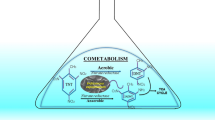Abstract
Manufacture of nitroorganic explosives generates toxic wastes leading to contamination of soils and waters, especially groundwater. For that reason bacteria living in environments highly contaminated with 2,4,6-trinitrotoluene (TNT) and other nitroorganic compounds were investigated for their capacity for TNT degradation. One isolate, Raoultella terrigena strain HB, removed TNT at concentrations between 10 and 100 mg l−1 completely from culture supernatants under optimum aerobic conditions within several hours. Only low concentrations of nutrient supplements were needed for the cometabolic transformation process. Radioactivity measurements with ring-labelled 14C–TNT detected about 10–20% of the initial radioactivity in the culture supernatant and the residual 80–90% as water-insoluble organic compounds in the cellular pellet. HPLC analysis identified aminodinitrotoluenes (2-ADNT, 4-ADNT) and diaminonitrotoluenes (2,4-DANT) as the metabolites which remained soluble in the culture medium and azoxy-dimers as the main products in the cell extracts. Hence, the new isolate could be useful for the removal of TNT from contaminated waters.
Similar content being viewed by others
Abbreviations
- ADNT:
-
aminodinitrotoluene
- DANT:
-
diaminonitrotoluene
- TN-4,4′-azo:
-
2,2′,6,6′-tetranitro-4,4′-azotoluene
- TN-2,2′-azoxy:
-
4,4′,6,6′-tetranitro-2,2′-azoxytoluene
- TN-4,4′-azoxy:
-
2,2′,6,6′-tetranitro-4,4′-azoxytoluene
- TNT:
-
2,4,6-trinitrotoluene
References
Claus H, Jackson H, Filip Z, (1995) Characterization of Serratia entomophila strains by genomic DNA fingerprints and plasmid profiles Microbiol. Res. 150: 159–166
Drancourt M, Bollet C, Carta A, Rousselier P, (2001) Phylogenetic analyses of Klebsiella species delineate Klebsiella and Raoultella gen. nov., with description of Roultella ornithinolytica comb.nov., Raoultella terrigena comb. Nov. and Raoultella planticola comb. nov Int. I. Syst. Evol. Microbiol. 51: 925–932
Fritsche W, Scheibner K, Herre A, Hofrichter M, (2000) Fungal degradation of explosives: TNT and related nitroaromatic compounds. In: Spain JC, Hughes JB, Knackmus HJ, (Eds) Biodegradation of Nitroaromatic Compounds and Explosives CRC Press Boca Raton, 213–237
Fuller ME, Hatzinger PB, Rungmakol D, Schuster RL, Steffan RJ, (2004) Enhancing the attenuation of explosives in surface soils at military facilities: combined sorption and biodegradation Environ. Tox. Chem. 23: 313–324
Fuller ME, Manning Jr JF, (1997) Aerobic Gram-positive and Gram-negative bacteria exhibit differential sensitivity to and transformation of 2,4,6-trinitrotoluene (TNT) Curr. Microbiol. 35: 77–83
Hawari J, Beaudet S, Halasz A, Thiboutot S, Ampleman G, (2000) Microbial degradation of explosives: biotransformation versus mineralization Appl. Microbiol. Biotechnol. 54: 605–618
Heiss G, Knackmus HJ, (2002) Bioelimination of trinitroaromatic compounds: immobilisation versus mineralization Curr. Opin. Microbiol. 5: 282–287
Honeycutt ME, Jarvis AS, McFarland VA, (1996) Cytotoxicity and mutagenicity of 2,4,6-trinitrotuene and its metabolites Ecotox. Environ. Safety 35: 282–287
Kalafut T, Wales ME, Rastogi VK, Naumova RP, Zaripoca SK, Wild JR, (1998) Biotransformation patterns of 2,4,6-trinitrotoluene by aerobic bacteria Curr. Microbiol. 36: 45–54
Kim HY, Bennett GN, Song HG, (2002) Degradation of 2,4,6-trinitrotoluene by Klebsiella sp. isolated from activated sludge Biotechnol. Lett. 24: 2023–2028
Kim HY, Song HG, (2005) Purification and characterization of NAD(P)H-dependent nitroreductase I from Klebsiella sp. C1 and enzymatic transformation of 2,4,6-trinitrotoluene Appl. Microbiol. Biotechnol. (in press)
Kröger M, Fels G, (2000) 14C-TNT synthesis revisited J. Labelled Cpds. Radiopharm. 43: 217–227
Kröger M, Schumacher ME, Risse H, Fels G, (2004) Biological reduction of TNT as part of a combined biological-chemical procedure for mineralization Biodegradation 15: 241–248
Lachance B, Robidoux PY, Hawari J, Ampleman G, Thiboutout S, Sunahara GI, (1999) Cytotoxic and genotoxic effects of energetic compounds on bacterial and mammalian cells in vitro Mutat. Res. 444:25–39
Lenke H, Achtnich C, Knackmus HJ, (2000) Perspectives of bioelimination of polynitroaromatic compounds. In: Spain JC, Hughes JB, Knackmus HJ, (Eds) Biodegradation of Nitroaromatic Compounds and Explosives CRC Press Boca Raton, 91–126
Lewis TA, Newcombe DA, Crawford RL, (2004) Bioremediation of soils contaminated with explosives J. Environ. Management 70: 291–307
Oh BT, Sarath G, Shea PJ, Drijber RA, Comfort SD, (2000) Rapid spectrophotometric determination of 2,4,6-trinitrotoluene in a Pseudomonas enzyme assay J. Microbiol. Methods 42: 149–158
Oh BT, Shea PJ, Drijber RA, Vasilyeva Gk, Sarath G, (2003) TNT biotransformation and detoxification by a Pseudomonas aeruginosa strain Biodegradation 14: 309–319
Pak JW, Knoke KL, Noguera DR, Fox BG, Chambliss GH, (2000) Transformation of 2,4,6-trinitrotoluene by purified xenobiotic reductase B from Pseudomonas fluorescens I-C Appl. Environ. Microbiol. 66: 4742–4750
Preuß J, Eitelberg F, (1999) Hallschlag Mainzer Georgraphische Sudien 45:384
Preuß J, Haas R, (1987) Die Standorte der Pulver-, Sprengstoff-, Kampf- und Nebelstofferzeugung im ehemaligen Deutschen Reich Geogr. Rundsch. 39: 578–584
Rosser SJ, Basran A, Travis ER, French CE, Bruce NC, (2001) Microbial transformation of explosives. In: Laskin AI, Bennett JW, Gadd G, (Eds) Advances in Applied Microbiology, Vol. 49 San Diego Academic Press, 1–35
Sitzmann ME, (1974) Chemical reduction of 2,4,6-trinitrotoluene – initial products J. Chem. Eng. Data 19: 179–181
Spannggord RJ, Stewart KR, Riccio ES, (1995) Mutagenicity of tetranitroazoxytoluenes: a preliminary screening in Salmonella typhimurium strains TA100 and TA100NR Mutat. Res. 335: 207–211
Thiele S, Fernades E, Bollag JM, (2002) Enzymatic transformation and binding of labelled 2,4,6-trinitrotoluene to humic substances during anaerobic/aerobic incubation J. Environ. Qual. 31: 437–444
van Aken B, Agathos SN, (2001) Biodegradation of nitro-substituted explosives by white-rot fungi: a mechanistic approach In: Laskin AI, Bennett JW, Gadd G, (Eds) Advances in Applied Microbiology, Vol. 49 San Diego Academic Press, 1–77
Zhao JS, Fournier D, Thiboutot S, Ampleman G, Hawari J, (2004) Biodegradation and bioremediation of explosives. In Singh A, Ward OP, (Eds) Soil Biology I, Applied Bioremediation and Phytoremediation Springer-Verlag Berlin Heidelberg, 55–80
Acknowledgements
The authors appreciate a financial support by the “Zentrum für Umweltforschung der Johannes Gutenberg-Universität”. We also thank Martina Schlander for excellent technical assistance and Dr. D. Hennecke, Fraunhofer-Institut für Molekularbiologie und Angewandte Oekologie, for the combustion measurements.
Author information
Authors and Affiliations
Corresponding author
Rights and permissions
About this article
Cite this article
Claus, H., Bausinger, T., Lehmler, I. et al. Transformation of 2,4,6-trinitrotoluene (TNT) by Raoultella terrigena . Biodegradation 18, 27–35 (2007). https://doi.org/10.1007/s10532-005-9033-7
Received:
Published:
Issue Date:
DOI: https://doi.org/10.1007/s10532-005-9033-7




